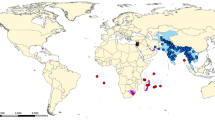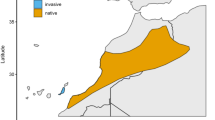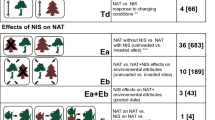Abstract
Despite intensive research on colonization by non-native species, ecologists still cannot accurately predict their invasive abilities and likely ecosystem impacts. This study was set out to analyze the determinants of the success of mammal introductions. We applied several types of phylogenetic linear and logistic multiple regression methods. Determinants of success were divided into external (introduction-specific) factors, principally introduction effort (measured as the number of introductions per species), and the proportion of introductions to islands/mainland; and intrinsic (species-specific) factors, including life history (litter size, body mass), ecological (diet breadth, activity breadth, trophic level), biogeographical (latitudinal range), and neuro-behavioral (brain size and sociality) traits. We found that the main determinants of introduction success are introduction-specific factors (i.e., introduction effort and island/mainland proportion) and not those of the species itself. A species’ neuro-cognitive traits are the exception, and these probably play a key role in the ability of founder individuals to recognize and utilize the resources available in novel environments and thus survive the bottleneck imposed by low initial population numbers.


Similar content being viewed by others
Availability of data and material
In Supplementary Information section.
Code availability
Not applicable.
References
Amiel JJ, Tingley R, Shine R (2011) Smart moves: effects of relative brain size on establishment success of invasive amphibians and reptiles. PLoS ONE 6(4):e18277
Bielby J, Mace GM, Bininda-Emonds OR, Cardillo M, Gittleman JL, Jones KE, ... & Purvis A (2007) The fast-slow continuum in mammalian life history: an empirical reevaluation. Am Natural 169(6):748-757
Blackburn TM, Pyšek P, Bacher S, Carlton JT, Duncan RP, Jarošík V, ... & Richardson DM (2011) A proposed unified framework for biological invasions. Trends Ecol Evol 26(7):333-339
Blackburn T, Scrivens S, Heinrich S, Cassey P (2017) Patterns of selectivity inintroductions of mammal species worldwide. NeoBiota 33:33–51
Blossey B, Notzold R (1995) Evolution of increased competitive ability in invasive nonnative plants-a hypothesis. J Ecol 83:887–889
Bomford M, Kraus F, Barry SC, Lawrence E (2009) Predicting establishment success for alien reptiles and amphibians: a role for climate matching. Biol Invasions 11(3):713
Burger JR, George MA Jr, Leadbetter C, Shaikh F (2019) The allometry of brain size in mammals. J Mammal 100(2):276–283
Callaway RM, Ridenour WM (2004) Novel weapons: invasive success and the evolution of increased competitive ability. Front Ecol Environ 2:436–443
Capellini I, Baker J, Allen WL, Street SE, Venditti C (2015) The role of life history traits in mammalian invasion success. Ecol Lett 18(10):1099–1107
Chapple DG, Simmonds SM, Wong BB (2012) Can behavioral and personality traits influence the success of unintentional species introductions? Trends Ecol Evol 27(1):57–64
Darwin’s C (1859) On the origin of species. published on, 24
Davis MA (2009) Invasion biology. Oxford University Press on Demand
Ehrlich PR (1989) 989. Attributes of invaders and the invading process: vertebrates. Drake) A, Mooney HA, DiCasIri F, Groves RH, Kruger F], Rejmanek M, Williamson M. Biological Invasions: A Global Perspective. New York: Wiley, 315–328
Forsyth DM, Duncan RP, Bomford M, Moore G (2004) Climatic suitability, life-history traits, introduction effort, and the establishment and spread of introduced mammals in Australia. Conserv Biol 18:557–569
Hayes KR, Barry SC (2008) Are there any consistent predictors of invasion success? Biol Invasions 10:483–506
Holmes ND, Spatz DR, Oppel S, Tershy B, Croll DA, Keitt B et al (2019) Globally important islands where eradicating invasive mammals will benefit highly threatened vertebrates. PLoS ONE 14(3):e0212128
Holway DA, Suarez AV (1999) Animal behavior: an essential component of invasion biology. Trends Ecol Evol 14(8):328–330
Hui C, Richardson DM, Landi P, Minoarivelo HO, Garnas J, Roy HE (2016) Defining invasiveness and invasibility in ecological networks. Biol Invasions 18(4):971–983
Ives AR, Garland T Jr (2010) Phylogenetic logistic regression for binary dependent variables. Syst Biol 59(1):9–26
Ives AR, Helmus MR (2011) Generalized linear mixed models for phylogenetic analyses of community structure. Ecol Monogr 81(3):511–525
Ives AR, & Garland T (2014) Phylogenetic regression for binary dependent variables. In Modern phylogenetic comparative methods and their application in evolutionary biology (pp. 231–261). Berlin, Heidelberg: Springer
Jeschke JM (2008) Across islands and continents, mammals are more successful invaders than birds. Divers Distrib 14(6):913–916
Jeschke JM, Debille S, & Lortie CJ (2018) Biotic resistance and island susceptibility hypotheses. Invasion biology hypothesis and evidence, 60–70
Keane RM, Crawley MJ (2002) Exotic plant invasions and the enemy release hypothesis. Trends Ecol Evol 17(4):164–170
Kumschick S, Gaertner M, Vilà M, Essl F, Jm Jeschke P, Pyšek A, Ricciardi S, Bacher TM, Blackburn JTA, Dick T, Evans PE, Hulme I, Kühn A, Mrugała J, Pergl W, Rabitsch DM, Richardson A, Sendek MW (2015) Ecological impacts of alien species: quantification, Scope, Caveats, and recommendations. Bioscience 65:55–63
Lefebvre L, Whittle P, Lascaris E, Finkelstein A (1997) Feeding innovations and forebrain size in birds. Anim Behav 53:549–560
Lodge DM (1993) Biological invasions: lessons for ecology. Trends Ecol Evol 8:133–137
Long JL (2003) Introduced Mammals of the World: Their History, Distribution and Influence. Melbourne: CSIRO Publishing
Ludsin SA, Wolfe AD (2001) Biological invasion theory: Darwin’s contributions from The Origin of Species. Bioscience 51(9):780–789
Lukas D, Clutton-Brock TH (2013) The evolution of social monogamy in mammals. Science 341(6145):526–530
Luque GM, Bellard C, Bertelsmeier C, Bonnaud E, Genovesi P, Simberloff D, Courchamp F (2014) The 100th of the world’s worst invasive alien species. Biol Invasions 16(5):981–985
Martins EP, Hansen TF (1997) Phylogenies and the comparative method: a general approach to incorporating phylogenetic information into the analysis of interspecific data. Am Nat 149(4):646–667
Mundry R (2014) Statistical issues and assumptions of phylogenetic generalized least squares. In Modern phylogenetic comparative methods and their application in evolutionary biology (pp. 131–153). Berlin, Heidelberg: Springer
Paradis E, Claude J (2002) Analysis of comparative data using generalized estimating equations. J Theor Biol 218:175–185
Pimm S (1991) The Balance of Nature? Chicago: University of Chicago Press
Reddiex B, Forsyth DM, McDonald-Madden E, Einoder LD, Griffioen PA, Chick RR, Robley AJ (2007) Control of pest mammals for biodiversity protection in Australia I Patterns of control and monitoring. Wildl Res 33(8):691–709
Simberloff D (2013) Invasive species: what everyone needs to know. Oxford University Press
Sol D, Bacher S, Reader SM, Lefebvre L (2008) Brain size predicts the success of mammal species introduced into novel environments. Am Nat 172(S1):S63–S71
Sol D, Maspons J, Vall-Llosera M, Bartomeus I, García-Peña GE, Piñol J, Freckleton RP (2012) Unraveling the life history of successful invaders. Science 337(6094):580–583
Williamson MH, Fitter A (1996) The characters of successful invaders. Biol Cons 78(1–2):163–170
Wilman H, Belmaker J, Simpson J, de la Rosa C, Rivadeneira MM, Jetz W (2014) EltonTraits 1.0: Species‐level foraging attributes of the world’s birds and mammals: Ecological Archives E095‐178. Ecology 95(7):2027–2027
Acknowledgements
We thank T. Blackburn, A. Zimmermann, I. Capellini, P. Wasowicz and J.R. Burger for their kind responses to our requests for information about their databases and publications.
Author information
Authors and Affiliations
Corresponding author
Ethics declarations
Ethics approval
Not applicable.
Consent to participate
Not applicable.
Additional declarations for articles in life science journals that report the results of studies involving humans and/or animals
Not applicable.
Competing interests
The authors declare no competing interests.
Additional information
Communicated by Andrzej Zalewski
Publisher's note
Springer Nature remains neutral with regard to jurisdictional claims in published maps and institutional affiliations.
Supplementary information
Below is the link to the electronic supplementary material.
Rights and permissions
About this article
Cite this article
Labaronnie, A., Cassini, M.H. Determinants of introduction success in alien mammals. Mamm Res 67, 231–237 (2022). https://doi.org/10.1007/s13364-021-00599-y
Received:
Accepted:
Published:
Issue Date:
DOI: https://doi.org/10.1007/s13364-021-00599-y




